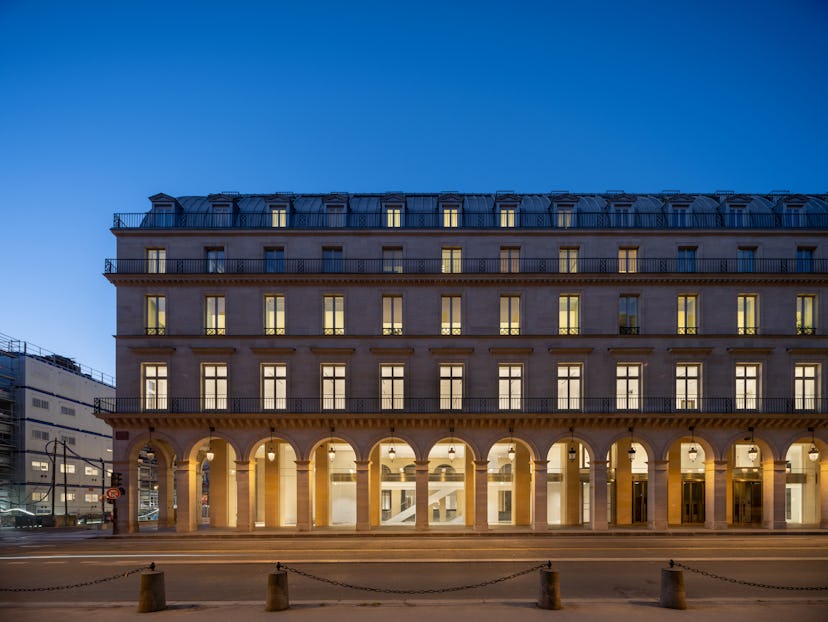Fondation Cartier’s Latest Museum Invents New Ways of Displaying Art
Inside the opening show “Exposition Générale,” open now at the architectural marvel in Paris.

As Art Basel Paris began this week—with its attendant satellite fairs, gallery openings, parties, and museum exhibitions—the conversation was dominated by the peculiarly timed jewelry heist at the Louvre, which might as well have been cribbed from an Arsène Lupin novel. Quel drame! The day after the robbery, however, attention quickly turned to a much happier event. After ten years of arduous planning and construction, the new Fondation Cartier for Contemporary Art opened.
Its previous space was ample and luminous, and hosted memorable exhibitions, but it was far from the city center. The new building, designed by Jean Nouvel, is literally a stone’s throw away from the Louvre museum, in what was once the Grand Hotel du Louvre, which opened in 1855 and was designed to host guests to the first Exposition Universelle in Paris. (Eventually it became a shopping mecca, the Grands Magasins du Louvre, and, since the late 1970s, the Louvre des Antiquaires, a chic antique mall.) The stately Haussmannian facade remains intact, but that’s about it—inside, Nouvel created nothing short of an architectural marvel.
Exhibition view at the Fondation Cartier featuring Cai Quo-Qiang’s The Earth Has its Black Hole Too: Project for Extraterrestrials No. 16, 1993, Mario Merz’s Tartaruga, 1975, and Panamarenko’s Panama, Spitzbergen, Nova Zemblaya, 1996
The building, which occupies a full city block and comprises 8,500 square meters, was conceived by Nouvel as a “machine” for transformable architecture. At its core there is a large central void that can be configured according to the specifications of different shows; most inner walls can be dismantled, and even the floors are moveable, using cable mechanisms discreetly tucked away in the corners. The opening show, titled “Exposition Générale,” was designed by the Italian studio Formafantasma to highlight the structural underpinnings of the building, upending the notion of the museum or gallery as a static white box. Here, entire exhibitions appear to float in space, accessible from above and below, and visible to passersby through the generous windows that connect the street to the works inside. In time there will be a restaurant on site, and the square of the Palais Royale, outside the main entrance, will serve as a forum for public art.
Luiz Zerbini’s Natureza Espiritual da Realidade (détail), 2012, Junya Ishigami’s Sydney Cloud Arch, 2018, and Santídio Pereira’s Sans titre, 2021
The Fondation Cartier was founded in 1984, and in addition to hosting major temporary exhibitions, it has amassed a significant permanent collection spanning painting, drawing, sculpture, textiles, photography, film, architecture, and design. Curated by Grazia Quaroni and Béatrice Grenier, “Exposition Générale” celebrates the Fondation’s multidisciplinary approach in amassing this collection and emphasizes a plurality of voices from cultures all over the world. There are pieces as diverse as Malick Sibidé’s joyful photographs of Malian youth; a massive wall hanging by the nonagenarian Colombian textile artist Olga de Amaral; a light room by James Turrell; gunpowder pieces by Cai Guo-Qiang; a stunning diptych by Joan Mitchell; a video work by Bill Viola; and a stone and hair sculpture by David Hammons, to name just a few.
Exhibition view of Malick Sidibé’s gelatin silver prints at the Fondation Cartier for Contemporary Art
Unlike the Louvre next door, the Fondation Cartier does not aim to be an encyclopedic museum, but rather a space for discovery and experimentation. Next to world-famous artists, the curators gave space to lesser-known figures like Freddy Mamani, a self-taught Bolivian architect who has created an Andean architectural style rooted in the culture of the Aymara, an indigenous tribe of the altiplano—but could be mistaken for an exuberant version of Memphis design. Native artists from the Gran Chaco, an area in Paraguay that has the highest deforestation rate in the world, are given pride of place, as is an abstract piece by Sally Gabori, an Australian aboriginal artist who started painting in her 80s.
Freddy Mamani's site-specific environment at the Fondation Cartier
It is no small thing that a newly revamped and expanded art institution is now exploring alternative perspectives and work from all geographies, smack in the center of Paris. “The Fondation Cartier has long been a fertile ground for dialogues between creators, thinkers, and researchers,” said Chris Dercon, the managing director of the museum. “‘Exposition Générale’ reaffirms its commitment to bringing together all creative disciplines and continuing to invent new ways of displaying art.”